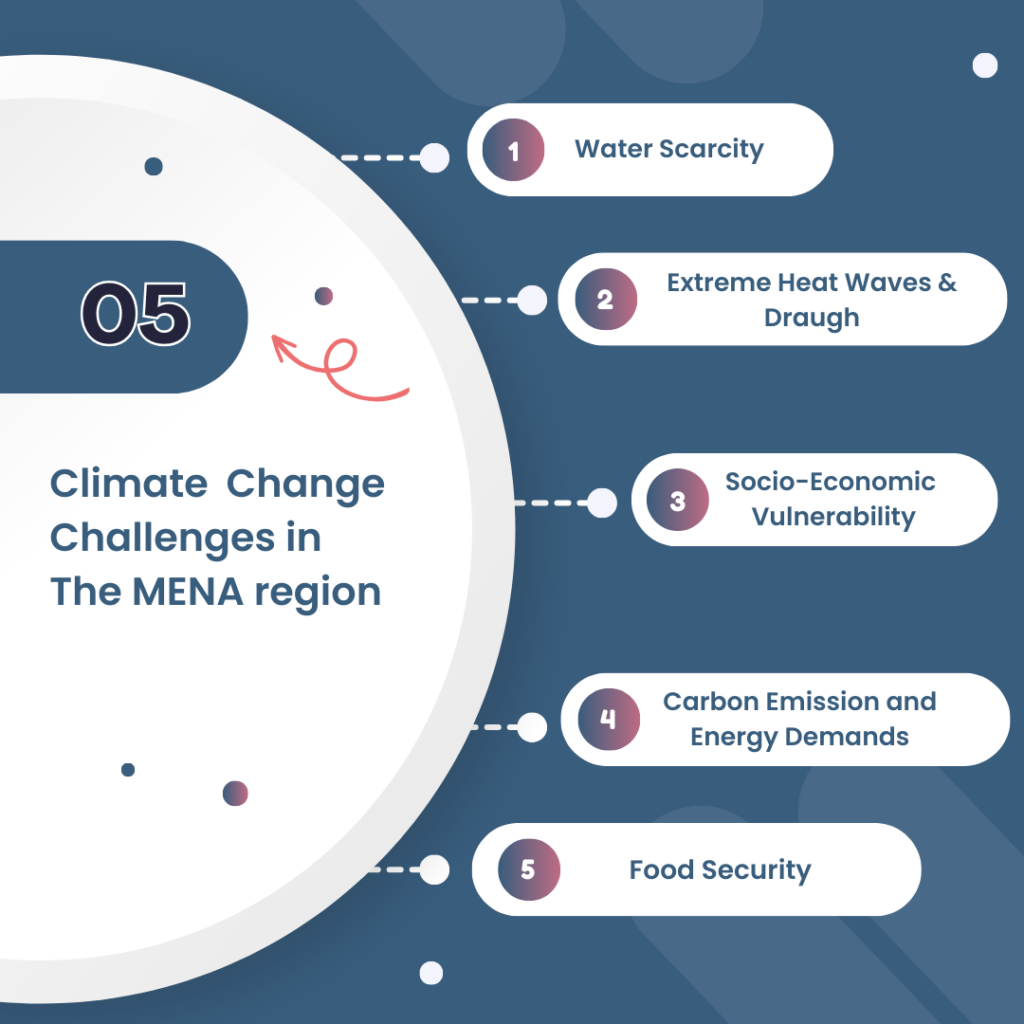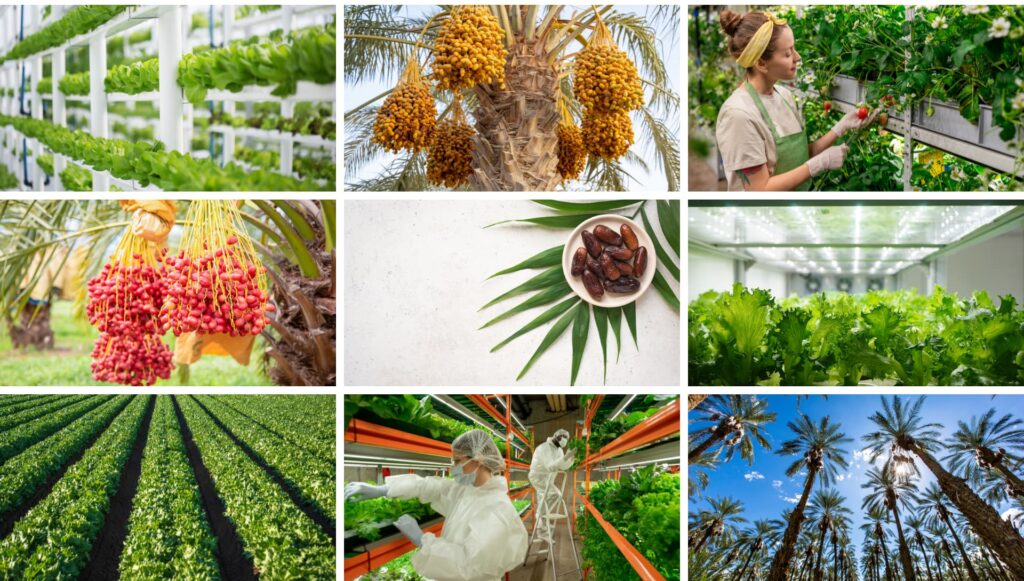The MENA (Middle East and North Africa) region comprises 14 countries, ranging from low-middle to high-class populations. The population in this region resides, as is the case globally, depends on agriculture and similar practices. Looking closely at the trends, you will see that food scarcity and agricultural challenges are growing in this region. The image below clearly shows how the agriculture market size will increase in the coming years, which forces us to put efforts into turning things in favour of the MENA people.
The fact you need to get clarity before researching the agricultural and climatic challenges is why these issues have come to the limelight. So, the MENA region has an arid climate with water scarcity. Furthermore, there has been a drastic rise in temperature, changes in precipitation patterns, and an increased number of extreme weather events, like heatwaves/draughts and even floods in worst cases.
All the climatic changes and challenges have made it difficult for agriculture. The only thing probably bucking the trend is date fruit, which has been a favorite part of life for the people living in GCC for centuries now.
Read How Dates Are Shaping The GCC’s Economy.
However, as the environment or the climate does not support the growth of crops, there is a need to adapt to some strategies that can boost food security in these regions. Responsible and renowned companies opt for climate-smart agriculture to ensure adequate plantation and minimum possible impact on the environment.
In this article, we will take a comprehensive look at how the agriculture sector in the MENA region is preparing for climate change.
Farm To Plate Research: Climate Change Challenges in the MENA region and ways to cope with them

1. Challenge: Water Scarcity
The MENA region is amongst the most water-scarce areas around the globe, with limited resources for freshwater. Moreover, the population growth has raised the water demand, putting additional pressure on the available resources. This rapid urbanization, lack of natural resources and growing demand have exacerbated water scarcity as a pressing issue. As a result of this, accessing clean water for agricultural purposes is becoming difficult, leading to food insecurity.
Solution: The most significant strategy is to bring sustainable water management practices into action to cope with the water scarcity issue. Address the fact that there is water scarcity, and something has to be done to meet the growing demand. It includes investing in water infrastructure, like setting up desalination plants or powering the wastewater treatment facilities to augment freshwater supply. Moreover, government bodies and other organizations working towards the agricultural field should promote water conservation measures. As per a report, Saudi Arabia is investing heavily in water desalination to ensure efficient usage of available water.
2. Challenge: Extreme Heat Waves & Draughts
Another climatic challenge that this region faces is extreme temperatures and prolonged droughts. This climatic change has adverse impacts on agriculture, public health, and ecosystems, making the lives of locals difficult. Draughts disrupt agricultural production and if something isn’t done on a serious note, meeting the basic food needs would be extremely challenging.
Solution: Coping strategies for draughts or extreme heatwaves that damage crops include developing infrastructure that is heat-resilient. It signifies the integration of climate risk considerations into development planning, infrastructure design, and disaster preparedness strategies. The setup should be such that there are early warning systems for extreme weather events, such as heatwaves and droughts. Through this, the people and acting bodies will get alert on time, minimizing the impacts on vulnerable populations. Furthermore, one can opt for sustainable agricultural practices, investing only in crops that are draught-resistant.
3. Challenge: Carbon Emission and Energy Demands
The Middle East and North Africa region is a major contributor and consumer of fossil fuels, which adds to greenhouse gas emissions and climate change in this area. Moreover, rapid urbanization and industrialization in the MENA region have led to high energy demand, exacerbating carbon emissions and air pollution. Dependence on fossil fuels for energy generation perpetuates the carbon footprint of this region and hampers efforts to transition to cleaner energy sources. All this makes the environment extremely polluting, and the land becomes unfit for growing healthy crops that are fit for consumption.
Solution: Coping strategies include considerable investment in renewable energy sources and increasing the dependency on solar and wind power solutions. This way, you can reduce the reliance on fossil fuels and save the environment around you. Investing in solar photovoltaic (PV) and concentrated solar power (CSP) projects and wind farms can help diversify the energy mix and promote sustainability. Furthermore, another coping mechanism is to enhance and popularize energy efficiency measures in buildings, industries, and transportation.
4. Challenge: Socio-Economic Vulnerability
Climate change fuels the existing social and economic vulnerabilities in the MENA region, including food insecurity. Most of the time, it is the marginalized communities, like rural populations and refugees, that bear the brunt of climate impacts due to limited resources. They face the inadequacy of bare minimums. Moreover, economic sectors reliant on natural resources, such as agriculture and tourism, are also vulnerable to climate variability and extreme weather events.
Solution: It is significant to strengthen social safety nets and build support mechanisms for the populations or communities that get worst affected to deal with the socio-economic vulnerability. Another effective solution is to invest in education, making people more aware of climate impacts and the apt ways to mitigate the loss.
5. Challenge: Food Security
Climate change poses an adverse impact on agriculture. Factors like water scarcity, heat stress, and changing precipitation patterns instigate significant challenges to food security in the MENA region. Moreover, agricultural productivity is affected by water stress, soil degradation, and pest infestations as well. Thus, the vulnerable populations, including smallholder farmers and rural communities, are particularly at risk of food insecurity. As per a report, MENA has about 6% of the world’s population. Out of this, more than 54 million people are undernourished.
Solution: Effective strategies to cope with the threat of food insecurity include diversifying agricultural practices to adapt to the ever-changing climatic conditions. Invest a lot in research and technology to understand and identify the challenges and choose the right ways to cope with them. Furthermore, the focus should be on enhancing regional cooperation in food trade to ensure fair distribution to eliminate localized food shortages.
These are the significant challenges the people in the MENA region face due to inevitable climatic changes. Government authorities and tech companies like Farm to Plate are making rigorous efforts to deal with the issues. Consistent efforts are made to come up with effective solutions to cope with the challenges and make healthy agricultural practices a reality for the people in the MENA region. Introducing technology to find cutting-edge solutions or implementing new policies, everything is done to provide a better life to the people in this area and ensure people at least get their fundamentals met.
Conclusion

The inevitable extremities that climate change brings pose multiple challenges for the MENA region. It ranges from water scarcity leading to draughts to food insecurity and social vulnerability. Though it has deeply affected the population, there is still hope to bring things back to normal. One can do so by adopting integrated strategies that emphasize adaptation, resilience, and sustainable development. Using these practices, this region can enhance its capacity to cope with climate change impacts and build a more resilient and favourable future. Moreover, an effective collaboration between governments, stakeholders, and international partners is essential for implementing effective climate solutions. Everyone can contribute their bit towards coping with the climatic change and ensure smoother operations in the agricultural sector.
Tanya A Mishra, Technical Content Writer & Marketer at farmtoplate.io (specialising in MENA Tech Landscape). She has been working towards crafting insightful content on topics like Blockchain, Agritech, AI and many more.
